| Solar eclipse of June 19, 1936 | |
|---|---|
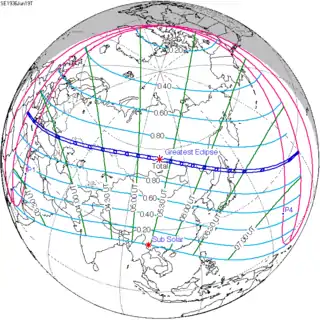 Map | |
| Type of eclipse | |
| Nature | Total |
| Gamma | 0.5389 |
| Magnitude | 1.0329 |
| Maximum eclipse | |
| Duration | 151 sec (2 m 31 s) |
| Coordinates | 56°06′N 104°42′E / 56.1°N 104.7°E |
| Max. width of band | 132 km (82 mi) |
| Times (UTC) | |
| Greatest eclipse | 5:20:31 |
| References | |
| Saros | 126 (43 of 72) |
| Catalog # (SE5000) | 9367 |
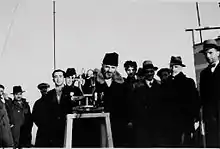
A total solar eclipse occurred at the Moon's descending node on Friday, June 19, 1936 (Thursday, June 18, 1936 east of the International Date Line). A solar eclipse occurs when the Moon passes between Earth and the Sun, thereby totally or partly obscuring the image of the Sun for a viewer on Earth. A total solar eclipse occurs when the Moon's apparent diameter is larger than the Sun's, blocking all direct sunlight, turning day into darkness. Totality occurs in a narrow path across Earth's surface, with the partial solar eclipse visible over a surrounding region thousands of kilometres wide. The path of totality crossed Europe and Asia. The full phase could be seen in Greece, Turkey, USSR, China and the Japanese island of Hokkaido. The maximum eclipse was near Bratsk and lasted about 2.5 minutes. The Sun was 57 degrees above horizon, gamma had a value of 0.539, and the eclipse was part of Solar Saros 126.
The Evening Standard reported that the "preparations for to-day's eclipse have been going forward for the past two years", and that a British expedition led by amateur astronomer R. L. Waterfield saw "excellent atmospheric conditions" from its observation point on Cap Sunium.[1] Similar observations were made by teams in Hokkaido, some hours later, allowing their observations of the Sun's corona to be compared "to find out whether any changes in shape or in detail of the corona have taken place in this interval".[1] A Russian team in Krasnoyarsk reported successful observation from a high-altitude balloon, where scientists "hoped to make observations at a height of some 15 miles".[1] There were also observers in the south of Greece, from Greece, Italy and Poland, the latter of which were "successful in obtaining cinematograph pictures of the eclipse".[1] Several long prominences (more than a million miles long) were observed, as well as the planet Venus.[1]
A United States expedition in Siberia conducted experiments on the ionosphere, with the Associated Press reporting that "indications that the earth's electrified roof, which, many miles above the surface of the globe, reflects back radio impulses, is formed mostly as a result of ultra-violet sun radiations appeared in preliminary results of the solar eclipse observations".[2]
Related eclipses
Solar eclipses 1935–1938
This eclipse is a member of a semester series. An eclipse in a semester series of solar eclipses repeats approximately every 177 days and 4 hours (a semester) at alternating nodes of the Moon's orbit.[3]
| Solar eclipse series sets from 1935–1938 | ||||
|---|---|---|---|---|
| Ascending node | Descending node | |||
| 111 | January 5, 1935 Partial |
116 | June 30, 1935 Partial | |
| 121 | December 25, 1935 Annular |
126 | June 19, 1936 Total | |
| 131 | December 13, 1936 Annular |
136 | June 8, 1937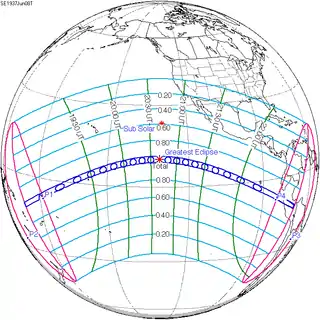 Total | |
| 141 | December 2, 1937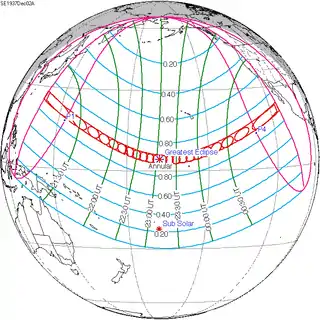 Annular |
146 | May 29, 1938 Total | |
| 151 | November 21, 1938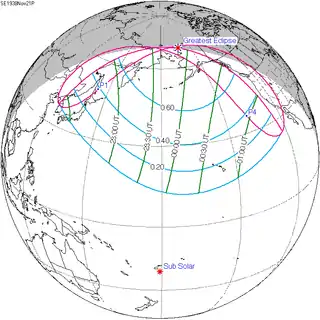 Partial | |||
Saros 126
It is a part of Saros cycle 126, repeating every 18 years, 11 days, containing 72 events. The series started with partial solar eclipse on March 10, 1179. It contains annular eclipses from June 4, 1323 through April 4, 1810, hybrid eclipses from April 14, 1828 through May 6, 1864 and total eclipses from May 17, 1882 through August 23, 2044. The series ends at member 72 as a partial eclipse on May 3, 2459. The longest duration of central eclipse (annular or total) was 6 minutes, 30 seconds of annularity on June 26, 1359. The longest duration of totality was 2 minutes, 36 seconds on July 10, 1972. All eclipses in this series occurs at the Moon’s descending node.
| Series members 42–52 occur between 1901 and 2100 | ||
|---|---|---|
| 42 | 43 | 44 |
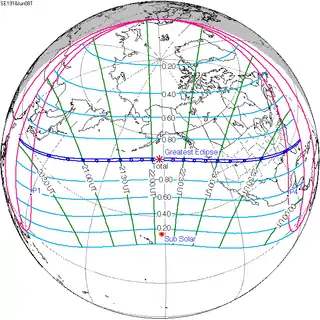 June 8, 1918 |
 June 19, 1936 |
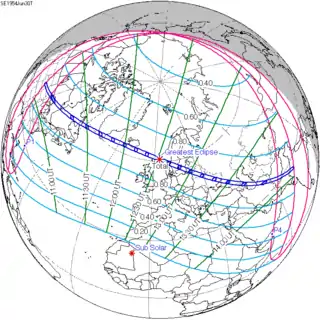 June 30, 1954 |
| 45 | 46 | 47 |
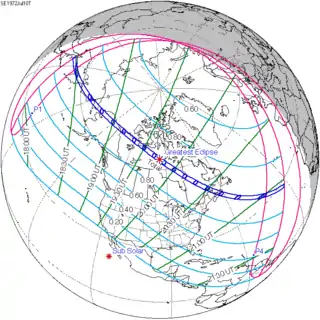 July 10, 1972 |
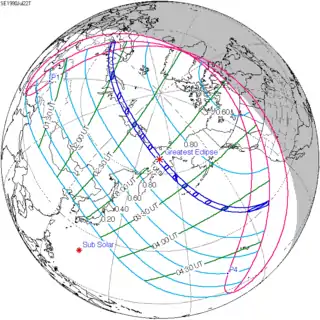 July 22, 1990 |
 August 1, 2008 |
| 48 | 49 | 50 |
 August 12, 2026 |
 August 23, 2044 |
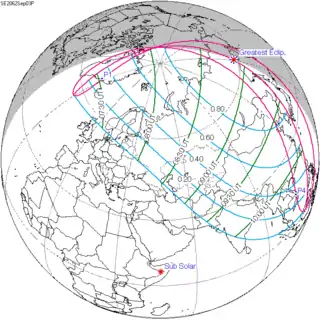 September 3, 2062 |
| 51 | 52 | |
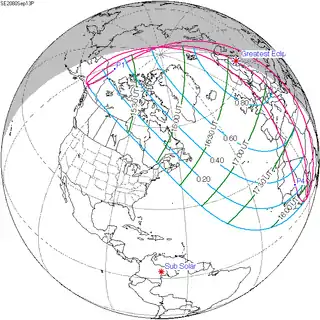 September 13, 2080 |
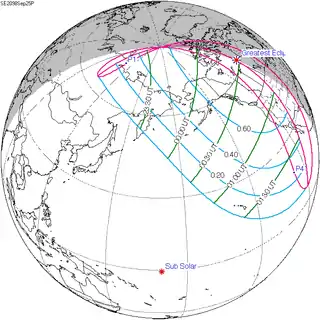 September 25, 2098 | |
Inex series
This eclipse is a part of the long period inex cycle, repeating at alternating nodes, every 358 synodic months (≈ 10,571.95 days, or 29 years minus 20 days). Their appearance and longitude are irregular due to a lack of synchronization with the anomalistic month (period of perigee). However, groupings of 3 inex cycles (≈ 87 years minus 2 months) comes close (≈ 1,151.02 anomalistic months), so eclipses are similar in these groupings.
| Inex series members between 1901 and 2100: | ||
|---|---|---|
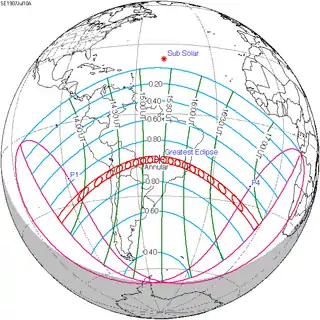 July 10, 1907 (Saros 125) |
 June 19, 1936 (Saros 126) |
 May 30, 1965 (Saros 127) |
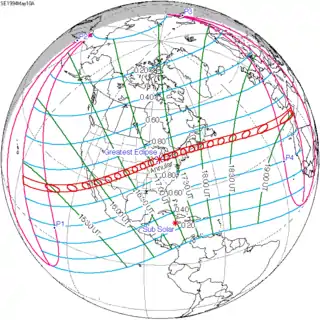 May 10, 1994 (Saros 128) |
 April 20, 2023 (Saros 129) |
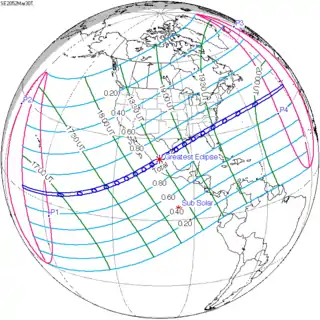 March 30, 2052 (Saros 130) |
 March 10, 2081 (Saros 131) |
||
Tritos series
This eclipse is a part of a tritos cycle, repeating at alternating nodes every 135 synodic months (≈ 3986.63 days, or 11 years minus 1 month). Their appearance and longitude are irregular due to a lack of synchronization with the anomalistic month (period of perigee), but groupings of 3 tritos cycles (≈ 33 years minus 3 months) come close (≈ 434.044 anomalistic months), so eclipses are similar in these groupings.
| Series members between 1901 and 2100 | |||
|---|---|---|---|
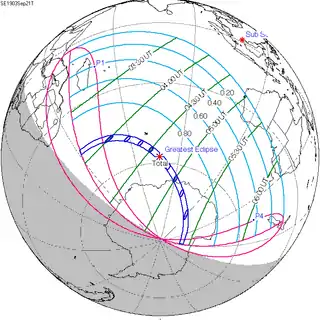 September 21, 1903 (Saros 123) |
 August 21, 1914 (Saros 124) |
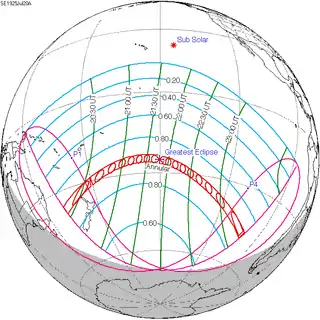 July 20, 1925 (Saros 125) | |
 June 19, 1936 (Saros 126) |
 May 20, 1947 (Saros 127) |
 April 19, 1958 (Saros 128) | |
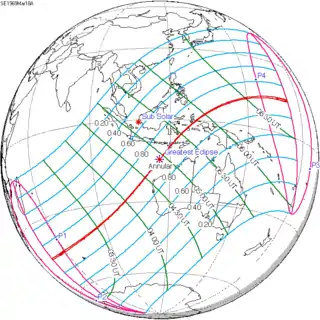 March 18, 1969 (Saros 129) |
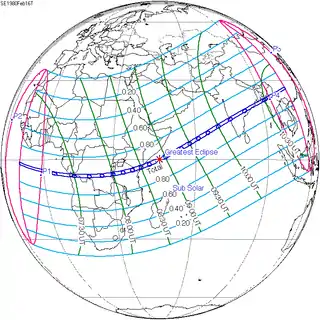 February 16, 1980 (Saros 130) |
 January 15, 1991 (Saros 131) | |
 December 14, 2001 (Saros 132) |
 November 13, 2012 (Saros 133) |
 October 14, 2023 (Saros 134) | |
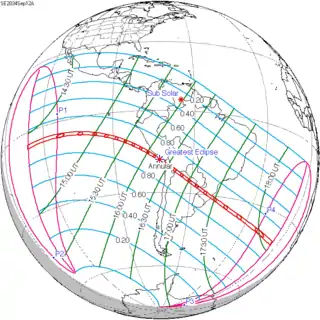 September 12, 2034 (Saros 135) |
 August 12, 2045 (Saros 136) |
 July 12, 2056 (Saros 137) | |
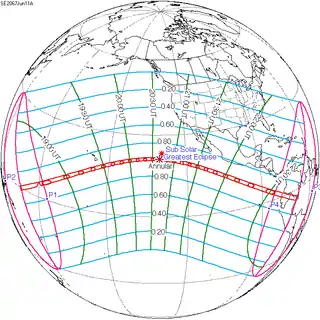 June 11, 2067 (Saros 138) |
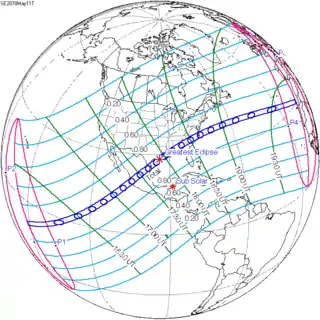 May 11, 2078 (Saros 139) |
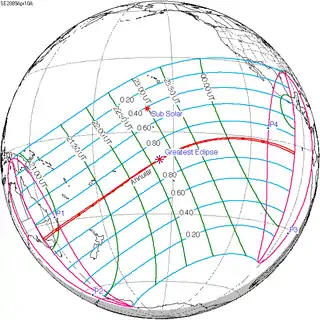 April 10, 2089 (Saros 140) | |
 March 10, 2100 (Saros 141) |
|||
Metonic series
The metonic series repeats eclipses every 19 years (6939.69 days), lasting about 5 cycles. Eclipses occur in nearly the same calendar date. In addition, the octon subseries repeats 1/5 of that or every 3.8 years (1387.94 days).
| 22 eclipse events, progressing from north to south between April 8, 1902 and August 31, 1989: | ||||
|---|---|---|---|---|
| April 7–8 | January 24–25 | November 12 | August 31-September 1 | June 19–20 |
| 108 | 114 | 116 | ||
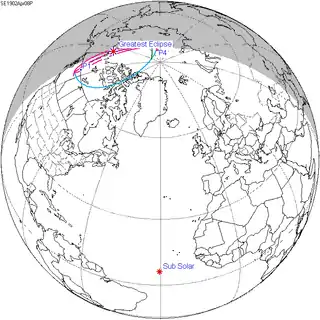 April 8, 1902 |
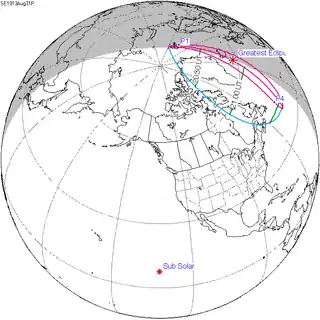 August 31, 1913 |
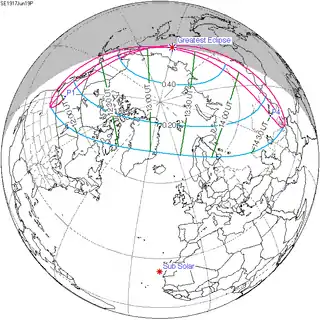 June 19, 1917 | ||
| 118 | 120 | 122 | 124 | 126 |
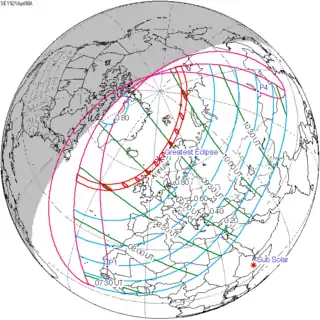 April 8, 1921 |
 January 24, 1925 |
 November 12, 1928 |
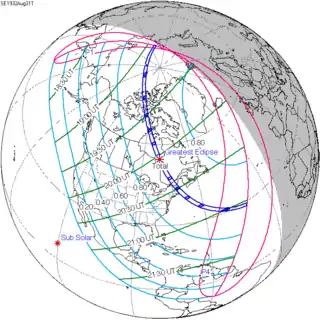 August 31, 1932 |
 June 19, 1936 |
| 128 | 130 | 132 | 134 | 136 |
 April 7, 1940 |
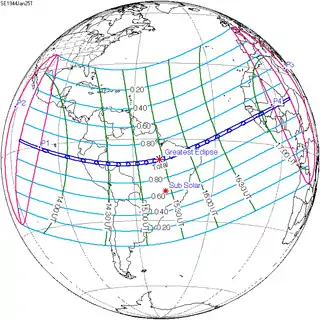 January 25, 1944 |
 November 12, 1947 |
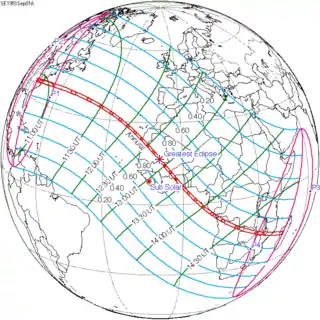 September 1, 1951 |
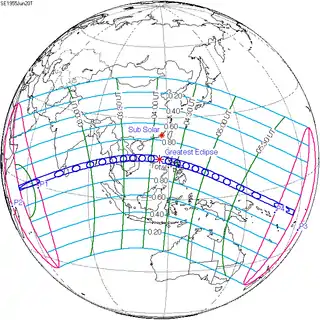 June 20, 1955 |
| 138 | 140 | 142 | 144 | 146 |
 April 8, 1959 |
 January 25, 1963 |
 November 12, 1966 |
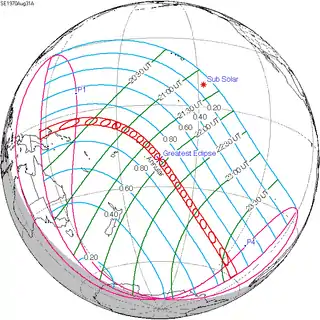 August 31, 1970 |
 June 20, 1974 |
| 148 | 150 | 152 | 154 | |
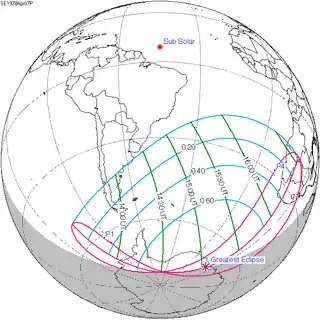 April 7, 1978 |
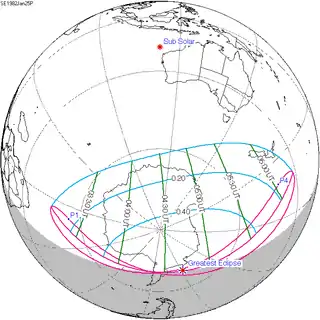 January 25, 1982 |
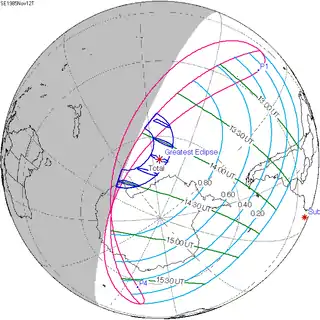 November 12, 1985 |
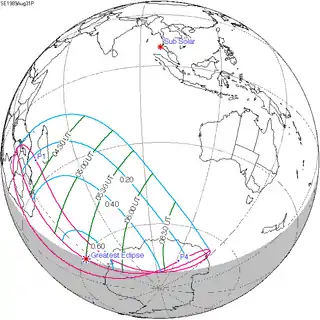 August 31, 1989 | |
Notes
- 1 2 3 4 5 "What the eclipse revealed". Evening Standard. London, Greater London, England. 1936-06-19. p. 14. Retrieved 2023-10-17 – via Newspapers.com.
- ↑ "Solar Eclipse Seen Clearly By U.S. Scientists in Siberia". The Buffalo News. Buffalo, New York. 1936-06-20. p. 2. Retrieved 2023-10-17 – via Newspapers.com.
- ↑ van Gent, R.H. "Solar- and Lunar-Eclipse Predictions from Antiquity to the Present". A Catalogue of Eclipse Cycles. Utrecht University. Retrieved 6 October 2018.
References
- Earth visibility chart and eclipse statistics Eclipse Predictions by Fred Espenak, NASA/GSFC
- Solar eclipse of June 19, 1936 in Russia
- Images of solar eclipse of June 19, 1936
- Map Kazakhstan Archived 2020-12-29 at the Wayback Machine
- Observing in Moscow
.jpg.webp)

